Tags
"winter fellowship for international travel"
Living in Clay Time In Clay Town: Kammy Chiu, Winter Fellowship for International Travel
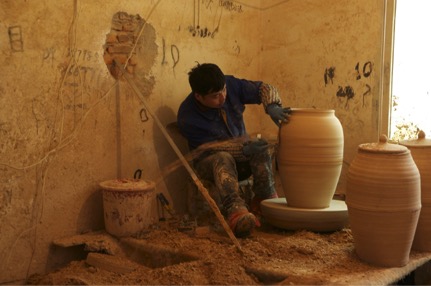
Kammy Chiu, sophomore Economics-ENV major and recipient of the Winter Fellowship for International Travel, reflects on her residency program with The Pottery Workshop in Jingdezhen, China, learning to work with porcelain.
The Pottery Workshop
My artistic residency with The Pottery Workshop (TPW) took place in The Sculpture Factory (TSF), Jingdezhen. For just over three weeks, I thought about absolutely nothing apart from clay. Three other international residents accompanied me during my time at TPW: Edith, an Israeli artist who specializes in painting porcelain tiles, Alberto, arguably one of the most knowledgeable mold-makers in the US who’s about to finish his MFA at Syracuse University, and Josh, another Reedie who introduced me to ceramics a year and a half ago.
Continue reading Living in Clay Time In Clay Town: Kammy Chiu, Winter Fellowship for International Travel
Learning to Let Go: A Ceramics Residency at The Pottery Workshop in Jingdezhen, China: Josh Tsang, Winter Fellowship for International Travel
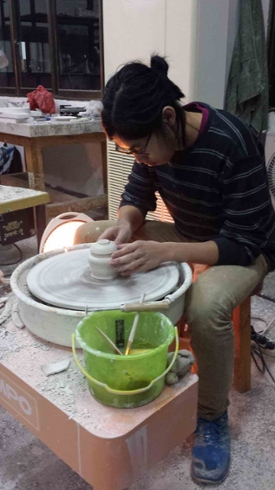
Josh Tsang, sophomore chemistry major and recipient of the Winter Fellowship for International Travel, reflects on his time in Jingdezhen, China, completing an artistic residency in Chinese ceramics.
Despite being safely at home in Portland, and having almost no school or work obligations, I still feel as if I am at the mercy of the external world. I have just completed an artistic residency at ‘The Pottery Workshop’ in Jingdezhen, China – a ‘small’ (for China) town known as the birthplace and capital of porcelain – and I have never felt so inexperienced in ceramics (not even when I first started making pottery 7 years ago). This isn’t because I haven’t learned anything or made progress in my work, but because everything I knew about how art and pottery works in North America was thrown on its head in Jingdezhen. That’s why I’ve titled this post “Learning to Let Go” because literally everything I knew, from producing work – the throwing, glazing, firing processes – to the conceptual idea of ceramic art was thrown out the window. I was starting from scratch.
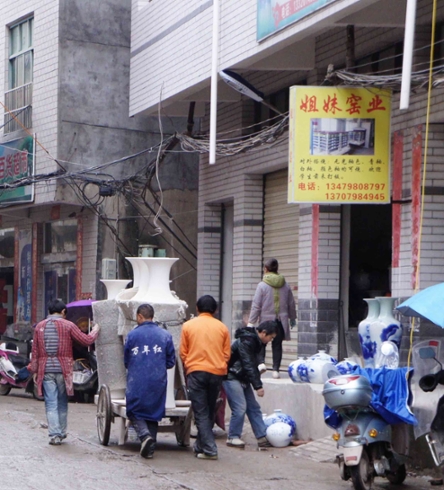
Continue reading Learning to Let Go: A Ceramics Residency at The Pottery Workshop in Jingdezhen, China: Josh Tsang, Winter Fellowship for International Travel
Capturing Climate Change in Madagascar: Kate Hilts, Winter Fellowship for International Travel
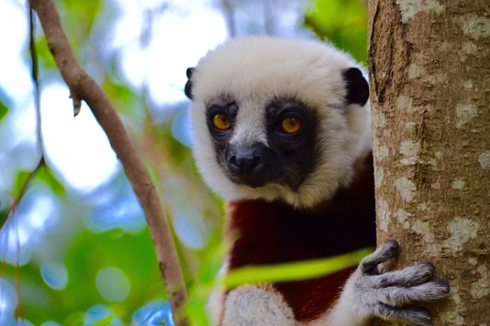
Kate Hilts, senior Environmental Studies-Political Science major and recipient of the Winter Fellowship for International Travel, shares some vignettes of her experience in Madagascar, photographing species endangered by climate change.
Near the end of my trip, I started to worry that I’d forget the details of my experience. Trying to hold onto the little details of Tana and its surroundings before I forget them, I started jotting random notes down in my phone, such as “harvested rice smells like freshly mown grass” and “private schools everywhere.” I compiled them all. Here are the bits and pieces:
Food:
Continue reading Capturing Climate Change in Madagascar: Kate Hilts, Winter Fellowship for International Travel
Alternative Mental Health Care, India: Savanah Walseth, Winter Fellowship for International Travel 2015

Savanah Walseth, junior Sociology major and recipient of the Winter Fellowship for International Travel, reflects on her time in India, exploring alternative models of mental health care.
My trip to India was a series of dichotomies. Anxiety about traveling to a country alone; pure joy in discovering things that only I would have found. Seeing some of the most fabulous beaches and most expensive buildings in the world; visiting the largest slum in Asia. Exhaustion from constant conversations about money and worry about theft; witnessing immense kindness from complete strangers. I was there to study mental health in the country and while I did this, I also learned a lot about my own.
I think the only way to sum up my trip is to take it one city at a time and share the lessons learn and a few tidbits about the people I met and things I saw.
Continue reading Alternative Mental Health Care, India: Savanah Walseth, Winter Fellowship for International Travel 2015
Ukrainian Language in Lviv: Isabel Meigs, Winter Fellowship for International Travel 2015

Isabel Meigs, senior Russian major and recipient of the Winter Fellowship for International Travel, reflects on her time in Ukraine, studying Ukrainian language and culture.
On the Sunday in between my two weeks of language instruction, I went on an excursion called “Karpatskii Tramvai + SPA”. The tour left at eight in the morning from the Hotel L’viv in a Mercedes mini-bus and drove three or so hours south of L’viv into the Ivano-Frankivsk oblast and the Carpathian Mountains. Our tour guide’s name was Yurii. Besides myself, there was a young couple whose common language (but neither of their native languages) was English, a mother/five-year-old son pair, a mother/teenage daughter pair, and a whole group of middle-aged friends from Dnipropetrovsk. And a French bulldog wearing a camo jacket.

Continue reading Ukrainian Language in Lviv: Isabel Meigs, Winter Fellowship for International Travel 2015
My Teacher: Tai Chi in China, Ian Connelly, Winter Fellowship for International Travel 2015
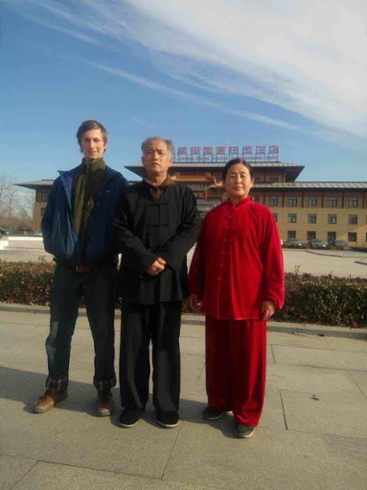
Ian Connelly, senior Chinese major and recipient of the Winter Fellowship for International Travel, reflects on his time in Beijing, China, practicing Tai Chi.
++++++++++++++++
My teacher’s name is Zhong Zhenshan. He comes from Handan in Hebei province, about 5 hours south of Beijing. He began studying taijiquan with his master Yao Jizu when he was thirteen years old and now he is one of the foremost lineage holders of Wu family style. He’s participated in many competitions, symposiums, and exhibitions both domestically and internationally and he has students all over the world.
Continue reading My Teacher: Tai Chi in China, Ian Connelly, Winter Fellowship for International Travel 2015
ASTRON Institute: Irene Globus-Harris, Winter Fellowship for International Travel

Westerbork
Irene Globus-Harris, sophomore physics major and recipient of the Winter Fellowship for International Travel, reflects on her time in Dwingeloo, the Netherlands, at ASTRON, the Netherlands Institute for Radio Astronomy.
++++++++++++++
The Dutch national color is orange. Bright orange, the type that hurts your eyes after staring at it too long. As I flew in at the break of dawn, the entire sky—awash in an intense, orange sunrise—seemed to reflect that fact. I spent the first few days visiting my host family and friends in North Holland, then headed to Dwingeloo to begin my work at ASTRON. Dwingeloo is small—more of a village than a town, and is adjacent to one of the Netherlands’ largest national parks, the Dwingelderveld. ASTRON itself sits within that national park which made the bike ride in exceptionally beautiful.
Winter Fellowship for International Travel: Emmeline Hill
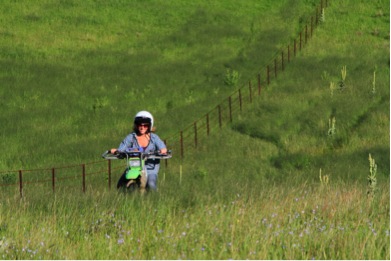
Emmeline Hill, senior biology major, traveled to Australia on a Reed Winter Fellowship for International Travel. The following post describes her experience getting to know the insects and sheep of the island continent.
“You haven’t seen a funnel web yet? Ah, if you like critters, we have to find one. You can just tell they’re predatory when you look at them.”
Thus began my tour through the garden of a friend of my host family on a search for Australia’s most deadly spider. We spent a good 20 minutes tramping barefoot through the dead leaves and branches littering the yard. As we went, Jon turned over various rocks and boards and investigated different crannies, hoping to come upon a funnel web spider. There are several species of funnel webs in Australia, six of which are severely venomous to humans (though there have been no known deaths since the development of an anti-venom in 1981). I’m still not sure if I am disappointed or relieved that no funnel webs decided to make an appearance.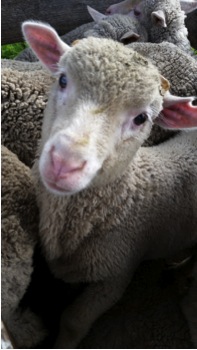
Before I left on my trip, countless people warned me about dangerous spider this and poisonous snake that, don’t go in the ocean and be careful in tall grass. But after a very short time in Australia I learned worrying about every potential threat was a waste of time (though I did check under my bed each night for Huntsman spiders, not because they are dangerous but because I didn’t want to wake up with one on my face). In Australia you don’t run away, you don’t say no because of the vague possibility of danger, you go searching for funnel web spiders, and you poke blue tongued lizards, and you back the truck up to get a second look at the red bellied black snake. I did my best to adopt this philosophy of not saying no. Even when I was exhausted or nervous, if a new opportunity was offered to me, I took it.
For the duration of my trip, I stayed with the Taylor family in the tiny town of Kentucky, New South Wales, on the 1,000-acre sheep farm that has been in the family for six generations. Currently, three generations of family live on the property together, creating a vibrant community of artists, intellectuals, and adventurers, each family member more often than not encompassing all three of those descriptors. I was on the farm as a helper; in exchange for room and board I worked 4-8 hours a day. No two days on the farm were the same, some days I herded sheep from one paddock to another, other days I set to work removing an invasive species of thistle, and sometimes I supervised the kids who almost exclusively wanted to play cards.
Continue reading Winter Fellowship for International Travel: Emmeline Hill
Argentinian Spanish in Buenos Aires: Winter Fellowship for International Travel, Cristobal Mancillas

Cristobal Mancillas, junior political science major and recipient of the Winter Fellowship for International Travel, reflects on his time in Buenos Aires, Argentina, studying Argentinian Spanish
I spent my winter travel fellowship in the beautiful city of Buenos Aires, Argentina. I received private Spanish instructions from professor Susana. The focus was on building conversational fluidity and learning an Argentinian dialect of Spanish. Professor Susana was a compassionate and caring individual who helped me adjust to a new place, a new language, and a new way of life. We spent time discussing art in the park of memory, dedicated to the memory of those who lost their lives in the Argentinian Dirty War, receiving an unofficial and spontaneous private tour of the Argentinian national bank, and relaxing while eating choripan at a nature reserve in Puerto Madero. While I could endlessly recount the amazing experiences I had in Buenos Aires, I feel that it was also the not so rosy experiences that allowed me the tremendous opportunity to grow.

Continue reading Argentinian Spanish in Buenos Aires: Winter Fellowship for International Travel, Cristobal Mancillas
Leadership and Aikido in Japan: Rebeca Willis-Conger, Fellowship for Winter International Travel

Yoko Sensei (center, front) surrounded by her dojo
Rebeca Willis-Conger, sophomore sociology major, received a Reed Fellowship for International Travel to study Aikido in Japan.
I love traveling. I always get nervous before leaving, convinced that I am not adequately prepared, anxious about all the accidents that might befall me. Then I leave my comfort zone and rediscover how capable I am. The world becomes someplace exciting and new to explore, while my anxieties appear slightly ridiculous. My trip to Japan was no exception.

Continue reading Leadership and Aikido in Japan: Rebeca Willis-Conger, Fellowship for Winter International Travel
Art and Seoul: Kaori Freda, Winter Fellowship for International Travel
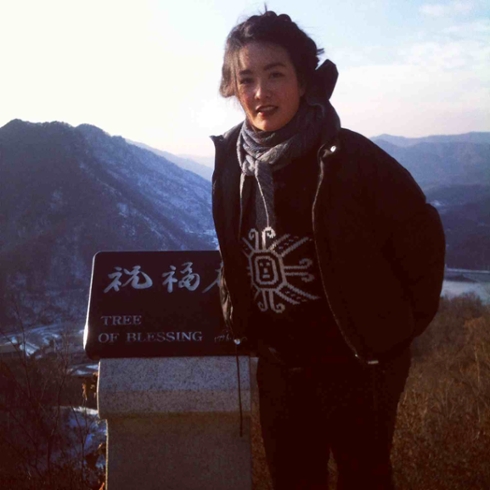
I am a senior art major who had the pleasure of traveling to Seoul during winter 2014 under the auspices of the Presidents Winter International Travel Fellowship. There, I stayed at the Unification Church Cheongpyeong holy grounds for a week taking photographs, making rubbings, and conducting on-site research. I’m intrigued by the ways in which this specific site of pilgrimage manipulates the movements of the body and mind and offers church members a tantalizing promise of eternal spiritual salvation. The Unification Church, also known as the Family Federation for World Peace and Unification, is the church of an international Christian religion. Founded in South Korea in 1954 by Reverend Sun Myung Moon, the church seeks to establish a Kingdom of Heaven on Earth. The church been criticized for its cultish practices, which include mass arranged marriages. The Unification Church directs its churchgoers to Cheongpyeong, located in Seoul. Although I am an avid nonbeliever, Moon arranged my parent’s marriage and I have unwillingly gone to Cheongpyeong multiple times in my childhood. This project sought a departure from my past with the religion by willfully confronting my memories on-site and creating artwork in order to move forward and grow both as a person and an artist.
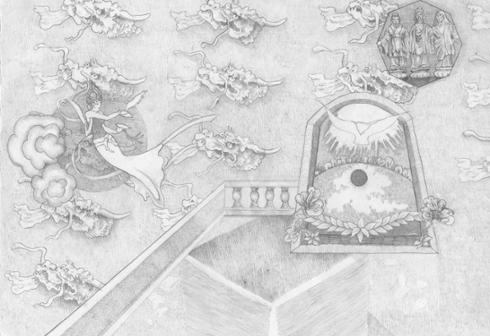
At Cheongpyeong, frigid weather gave hazy form to my breath as I exhaled. Each morning I bundled up before trekking up the Church’s holy mountain, making rubbings along the way. This mountain plays a crucial role as a site of pilgrimage and a harbinger of hope for what the church members conceive as their salvation and pathway to paradise. As they climb the mountain at daybreak during their religious training, the churchgoers pay their respects to holy trees and water imbued with spiritual energy. There is even a place called “Holy Water” where water bubbles and streams from the rocks for church members to quench their thirst as they trek up to the mountain top, not unlike the story of Moses striking the rocks and calling forth water in Numbers 20 in the Bible. Given that the foundation of Unificationism derives from a mishmash of religions including Christianity, I really wouldn’t be surprised if this reference to the Bible stood at the forefront of Moon’s mind as he constructed space and ritual at Cheongpyeong. These religious nodes would blend easily into the surrounding landscape if not for the fact that they are circumcised by a stone ring and marked with stone tablets incised with titles like “Tree of Blessing,” or “Tree of Life” in flowing calligraphic script. Church members believe that their holy ancestors and the spirits of the mountain flutter between the branches of these trees, gazing benevolently down at those who pray with devotion. In addition to these daily pilgrimages, they are confined within a strict itinerary in hopes of purifying their ancestors and exorcising evil spirits from their bodies. Although the strength of their piety is admirable, I’m dubious as to the amount of truth in such claims, especially given that Moon (who dubbed himself the Messiah) and his “Holy” family practiced corruption, domestic violence, amongst other sins. The leaders of the church certainly do not practice the values they preach. This untrustworthiness fractures their constructed divinity and places doubt onto the purity of the religious practices to which their followers adhere.
You Are Not A Fish: Winter Fellowship For International Travel, Reid Bondurant
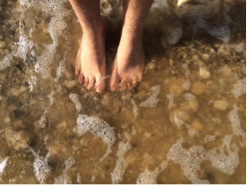
Reed Winter Fellowship for International Travel recipient Reid Bondurant, senior biology major, traveled to Tel Aviv, Israel to explore an awareness-inspiring style of dance known as “Gaga”
Tracing Faserland, Fellowship for Winter International Travel, Ben DeYoung
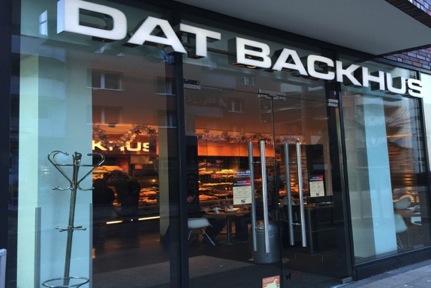
Ben DeYoung is retracing the steps of a trip across Germany as it is presented in the novel "Faserland" by Christian Kracht.
Excerpt from the first stop: Hamburg, Germany.
...I took to the street, unsure of what, exactly, I was looking for. In Hamburg, Faserland had not given me much to work with; he describes the light, but travels the city only at night, and spends most of his time in his friend's apartment. His main characterization of the city, other than his description of the light he does not actually see, comes in the form of what is also not actually there, namely the city that was destroyed. This unseen city, and the reconstruction of Hamburg, would eventually also play a large part in my impression of the place, but I was at least initially struck by a timeless aspect of the city, namely the dialect characteristic of Hamburg, and of its region, Schleswig-Holstein.
Blues Dancing Berlin, Fellowship for Winter International Travel, Serra Shelton
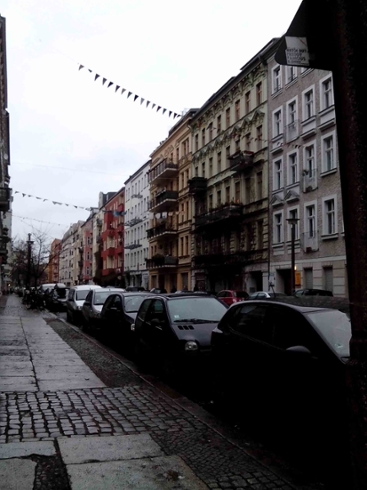
A little background info about my President’s Winter Fellowship project: I am a senior English major at Reed. I have been dancing in some shape or form since I was fourteen, but always solo performance dances: ballet, modern, contemporary, jazz, a little hip-hop here and there. And then, just a year
ago, I discovered social dancing. It has radically changed the way I view my body as a medium for communication. For me there have always been two competing mental states of mind when dancing. The first is performance mode. I conceive of my body as paint on a canvas: it is a fluid motion shape through which I can signify and provoke. The space, locomotion, appearance, and form of my body are visual/kinesthetic sites of meaning. The second state of mind is improvisation mode. This is a selfish mode: when I dance in this body it is almost always when I am by myself, and the movement is for me and me alone. It is an exploration of sensation, a creative play of momentum and shape. I am not concerned with the way my body looks, only with the way it feels as I move. The site of meaning in this type of dancing is not visible: it is an internal reflection on what it means to have a body that occupies space through time. Both of these modes of dancing have been imperative to my formation as a dancer, yet until I found social dancing I believed that these two modes could never intersect. Social dancing, and especially blues dancing, combines these two states of mind. In blues dancing the indulgent focus on sensation, which I thought was only capable solo, is able to be shared with a partner. This creates an incredible pattern of communication that I still struggle to adequately describe in words, and this wa
